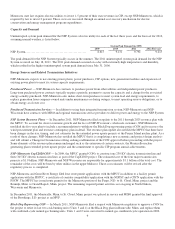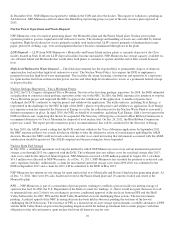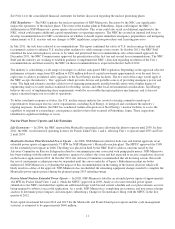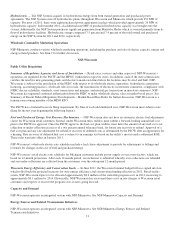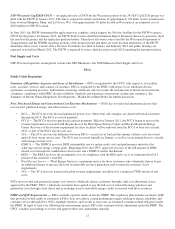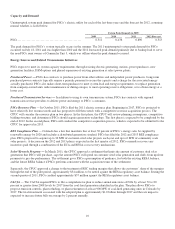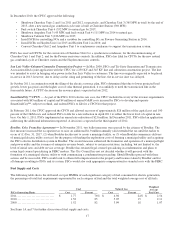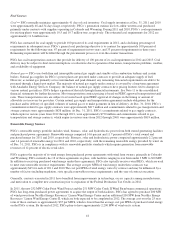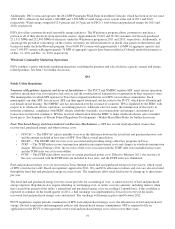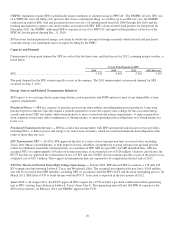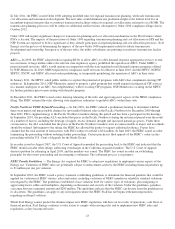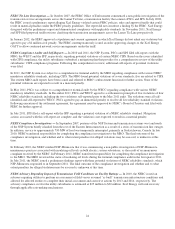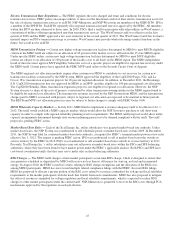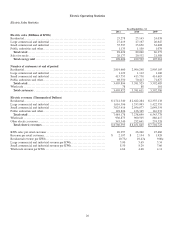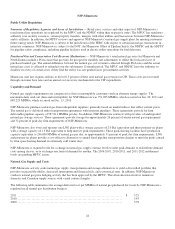Xcel Energy 2011 Annual Report Download - page 29
Download and view the complete annual report
Please find page 29 of the 2011 Xcel Energy annual report below. You can navigate through the pages in the report by either clicking on the pages listed below, or by using the keyword search tool below to find specific information within the annual report.19
Additionally, PSCo owns and operates the 26.4 MW Ponnequin Wind Farm in northern Colorado, which has been in service since
1999. PSCo collectively had nearly 1,800 MW and 1,300 MW of wind energy on its system at the end of 2011 and 2010,
respectively. Wind energy comprised 12.4 percent and 10.3 percent of PSCo’s total owned and purchased energy for 2011 and
2010, respectively.
PSCo also offers customer-focused renewable energy initiatives. The Windsource program allows customers to purchase a
portion or all of their electricity from renewable sources. Approximately 35,843 and 38,762 customers in Colorado purchased
211,511 MWh and 212,900 MWh of electricity under the Windsource program in 2011 and 2010, respectively. Additionally, to
encourage the growth of solar energy on the system, customers are offered incentives to install solar panels on their homes and
businesses under the Solar*Rewards program. Over 9,600 PV systems with approximately 110 MW of aggregate capacity and
over 7,100 PV systems with approximately 76 MW of aggregate capacity have been installed in Colorado under this program as
of Dec. 31, 2011 and Dec. 31, 2010, respectively.
Wholesale Commodity Marketing Operations
PSCo conducts various wholesale marketing operations, including the purchase and sale of electric capacity, energy and energy
related products. See Item 7 for further discussion.
SPS
Public Utility Regulation
Summary of Regulatory Agencies and Areas of Jurisdiction — The PUCT and NMPRC regulate SPS’ retail electric operations
and have jurisdiction over its retail rates and services and the construction of transmission or generation in their respective states.
The municipalities in which SPS operates in Texas have original jurisdiction over SPS’ rates in those communities. Each
municipality can deny SPS’ rate increase. SPS can then appeal municipal rate decisions to the PUCT, which hears all municipal
rate denials in one hearing. The NMPRC also has jurisdiction over the issuance of securities. SPS is regulated by the FERC with
respect to its wholesale electric operations, accounting practices, wholesale sales for resale, the transmission of electricity in
interstate commerce, compliance with NERC electric reliability standards, asset transactions and mergers, and natural gas
transactions in interstate commerce. SPS has received authorization from the FERC to make wholesale electric sales at market-
based prices. See Summary of Recent Federal Regulatory Developments - Market-Based Rate Rules for further discussion.
Fuel, Purchased Energy and Conservation Cost-Recovery Mechanisms — SPS has several retail adjustment clauses that
recover fuel, purchased energy and other resource costs:
• FPPCAC — The FPPCAC adjusts monthly to recover the difference between the actual fuel and purchased power costs
and the amount included in base rates of SPS’ New Mexico retail jurisdiction.
• EECRF — The EECRF rider recovers costs associated with providing energy efficiency programs in Texas.
• TCRF — The TCRF rider recovers transmission infrastructure improvement costs and changes in wholesale transmission
charges. Effective February 2011, the recovery of the costs associated with the TCRF rider were included in base rates
and the TCRF rider was set to zero dollars.
• PCRF — The PCRF rider allows recovery of certain purchased power costs. Effective February 2011, the recovery of
the costs associated with the PCRF rider are included in base rates, and the PCRF rider was eliminated.
Fuel and purchased energy costs are recovered in Texas through a fixed fuel and purchased energy recovery factor, which is part
of SPS’ retail electric tariff. Based on regulatory approval in 2011, SO2 and NOx allowance revenues and costs are also recovered
through the fixed fuel and purchased energy recovery factor. The regulations allow retail fuel factors to change up to three times
per year.
The fixed fuel and purchased energy recovery factor provides for accounting of over- or under-recovery of fuel and purchased
energy expenses. Regulations also require refunding or surcharging over- or under- recovery amounts, including interest, when
they exceed four percent of the utility’s annual fuel and purchased energy costs on a rolling 12-month basis, if this condition is
expected to continue. In the fourth quarter of 2011, a fuel surcharge was implemented in Texas for recovery of the under-
recovered fuel and purchased energy costs and interest. The surcharge will remain in place until October 2012.
PUCT regulations require periodic examination of SPS’ fuel and purchased energy costs, the efficient use of fuel and purchased
energy, the fuel acquisition and management policies and the purchased energy commitments. SPS is required to file an
application for the PUCT to retrospectively review fuel and purchased energy costs at least every three years.


